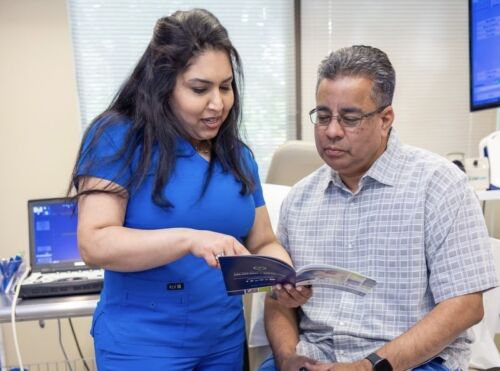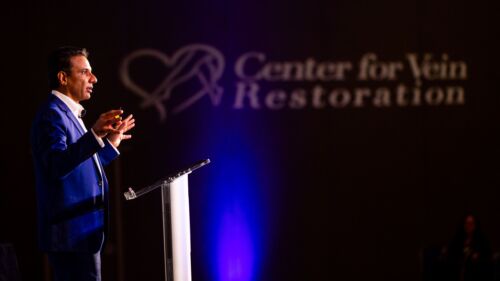A healthy heart is needed to maintain good blood circulation in your veins, so what can you do to ensure your heart stays in tip-top shape?
Your veins and heart work together to circulate blood and oxygen throughout your body. Each day, your heart beats 100,000 times to pump 5.6 liters (six quarts) of blood through your arteries and veins three times every minute. While arteries carry oxygenated blood throughout the body, the veins return deoxygenated blood back to the heart for another dose of oxygen.
That’s a big job for your heart and veins! If there is a malfunction anywhere in the circulatory system, you’ll likely experience vein-related symptoms. Let’s dive in to see how a strong heart goes hand-in-hand with healthy veins and blood circulation.
What happens if you have poor circulation?
Several symptoms that point to poor circulation are first felt in your veins. Venous insufficiency, a medical term for poor circulation in the veins, is revealed in these common symptoms:
Cold feet and legs. When blood cannot reach your lower extremities, your feet and legs may feel cold, even if other parts of your body feel warm.
Leg swelling and cramping. Tiny valves inside the leg veins move blood upward. When these valves weaken, blood pools within the vein walls, causing swelling and cramping in your legs.
Varicose veins. These knotted, distended veins that emerge along the legs and feet indicate a problem with your circulation.
Skin changes. Restricted circulation means nourishing blood cannot reach the skin, which can cause the skin to change color or take on a rough texture. Without treatment, the delicate skin may develop into a slow-healing ulcer.
Blood clots. Bood that doesn’t circulate and instead remains trapped in the vein can encourage blood cells to cluster and form a clot. A clot within a deep leg vein is known as deep vein thrombosis (DVT) and may exhibit symptoms such as pain, swelling, and reddish, warm-feeling skin. If the clot breaks away from the leg vein and lodges in the lung, it could cause a potentially life-threatening pulmonary embolism (PE). A PE must be treated immediately at an emergency room.
How to improve your circulation
While venous insufficiency or vein disease is not directly related to heart problems, the two conditions stem from similar risk factors, such as obesity, a sedentary lifestyle, and poor diet. Since healthy circulation depends on strong veins and heart, you can start your journey to better circulation by making these seven lifestyle changes:
Aerobic exercise. Aerobic exercises such as walking, biking, and swimming strengthen the heart muscle and keep the blood pumping. Consider taking advantage of the 200 miles of hiking and biking trails in the Phoenix area. Remember, it takes only 30 minutes of aerobic activity to boost your circulation.
Eat a heart and vein-healthy diet. A balanced diet of fruits, vegetables, whole grains, and lean proteins helps both your heart and your veins. Avoid sugary foods and saturated fats that can clog your blood vessels.
Manage your blood pressure. Hypertension is one of the leading causes of heart disease. But it can also damage your veins. Talk to your doctor about managing your high blood pressure through diet and medication.
Lose weight. Excess pounds can strain your heart and your veins. Keeping your weight at an ideal level may improve your circulation and relieve some symptoms of vein disease, such as pain and swelling.
Stop smoking. The chemicals in nicotine can restrict circulation. If you’re having trouble quitting, ask your doctor about a smoking cessation program.
Control your diabetes. Diabetes is not only bad for your heart, but it can damage your veins, too. If you’ve been diagnosed with diabetes, talk to your doctor about controlling your blood sugar with medication and diet.
Take your medications. If you need medications for heart disease, high blood pressure, or diabetes, take the drugs as prescribed. Your heart and veins will be healthier for it.
Visit the vein specialists in Phoenix
If poor circulation is causing pain, swelling, and varicose veins, visit one of three Center for Vein Restoration (CVR) locations around Phoenix, Arizona, for treatment! Each office is led by an experienced physician who can help you explore a full range of minimally invasive treatments to treat poor circulation and vein disease:
Khanh Q. Nguyen, DO, RPVI, has been in practice for almost two decades and is the Corporate Medical Director for Center for Vein Restoration.
Soohyun Kim, MD, RVT, brings her expertise as a vascular surgeon to treat every stage of vein disease.
Contact their offices today for a consultation or to speak to a representative. You may also schedule online at your convenience.
Don't live near an Arizona CVR vein clinic location? No problem! With over 100 vein clinic locations in 22 states and the District of Columbia, there's sure to be a CVR vein center near you.
3509 S. Mercy Road, Suite 101
Gilbert, AZ 85297
1500 S. Dobson Road, Suite 310
Mesa, AZ 85202
9515 W. Camelback Road
Suite 108 Phoenix, AZ 85037

 About Vein Disease
About Vein Disease
 Spider Veins
Spider Veins
 Varicose Veins
Varicose Veins
 Vein Disease Treatments
Vein Disease Treatments
 Treating Spider Veins
Treating Spider Veins
 Treating Varicose Veins
Treating Varicose Veins
 About Us
About Us
 Patient Resources
Patient Resources
 Physician Resources
Physician Resources


